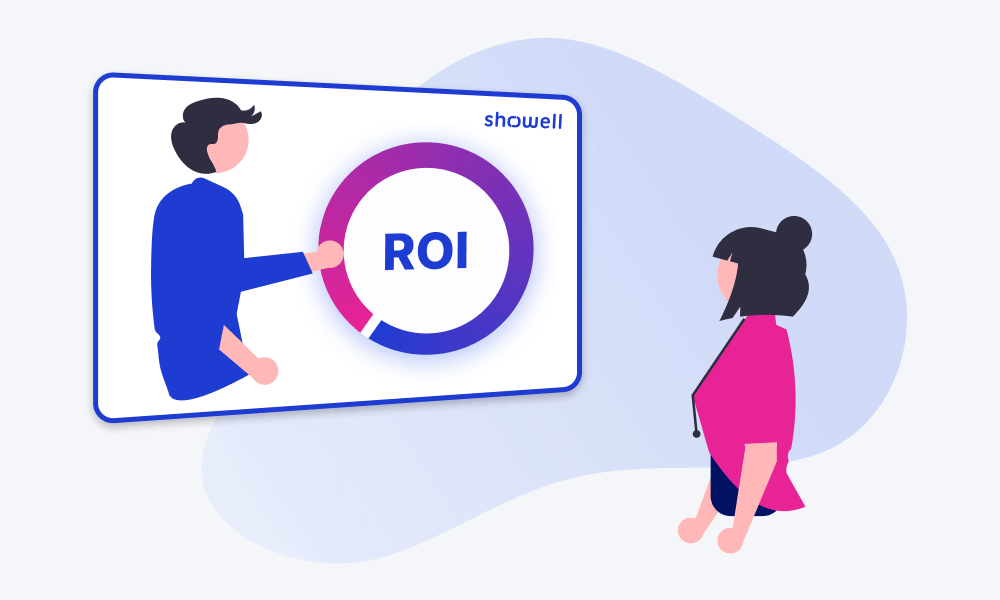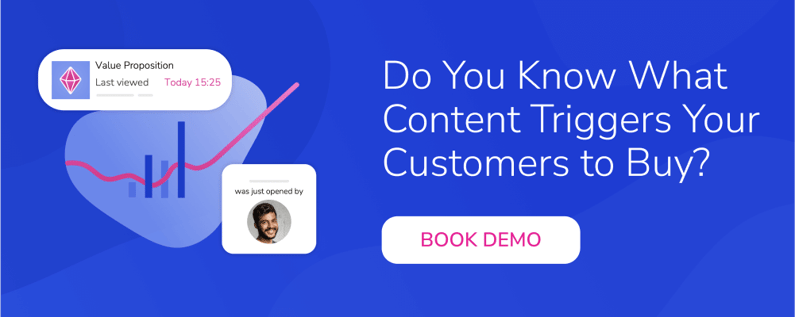Sales enablement is about providing the sales team with the tools, resources, and training they need to sell effectively. It has helped redefine sales approaches and strategies, but questions might linger like how to measure the success of sales enablement? How do we ensure our efforts in sales enablement are translating into results?
One of the modern management theory founders, Peter Drucker, once said, "What gets measured gets managed." This underscores the importance of tracking and monitoring to manage and improve the processes effectively.
Quantifying the success of sales enablement initiatives isn't just beneficial—it's crucial. Let’s delve into how to evaluate the success of sales enablement and understand its pivotal role in modern sales.
 Why Measure Sales Enablement?
Why Measure Sales Enablement?
Organizations are constantly trying to compete for every ounce of customer attention. Nowadays, it's more than just the survival of the fittest; it's the survival of the smartest.
Take the case of companies like Apple and Amazon. While they certainly have formidable products and services, what sets them apart is their strategic foresight and adaptability. Their strategies and approach continuously evolve, ensuring they remain attuned to their customers' needs and market shifts.
To harness the full potential of sales enablement, it's important for you and your team to zero in on and invest in the most impactful initiatives. Without a yardstick to measure, how can one improve?
Benefits of Measuring Sales Enablement
You can pinpoint where you stand and strategize the path forward by routinely assessing your strategies and tracking progress. Evaluating sales enablement is not just about measuring numbers but refining focus on the actions that deliver the highest returns.
When sales enablement is systematically measured and enhanced, it becomes the guiding light that ensures sales teams don't walk blindly but can navigate toward excellence.
Here are just some extra incentives in measuring sales enablement:
Validate Investment
Organizations spend considerable resources (time and money) on sales enablement tools, training, and content. Measuring its impact helps validate investments, ensuring they yield a positive return. It’s not just about using resources; it's about using them wisely. If a tool or technique isn’t yielding results, why continue pouring money into it?
Identify Gaps and Opportunities
Measurement can spotlight areas where sales reps might be struggling, allowing for targeted interventions. Conversely, it can also highlight strategies or tools that are particularly effective, which can then be scaled or emphasized.
Strengthen Cross-Functional Collaboration
Sales enablement isn't just the responsibility of the sales department. Marketing, product, and other teams play crucial roles. Measuring outcomes fosters better alignment and collaboration among these departments.
Drive Accountability
With clearly defined metrics, teams involved in the change become more accountable. When they know their performance is being tracked against specific criteria, they are more likely to adhere to best practices and strive for improvement.
Boost Morale and Motivation
Celebrating successes is crucial for team morale. When sales enablement efforts result in better performance, highlighting these achievements can motivate the entire team.
Provide Continuous Feedback
Regular measuring sales enablement success means regular feedback. This ongoing loop ensures that sales reps receive timely information about their performance, allowing them to adjust and improve in real time.
Align with Buyer Needs
As buyer behavior and preferences change, sales enablement efforts need to adapt. Measuring outcomes provides insights into what buyers respond to, ensuring that sales strategies remain aligned with their needs.
Increase Scalability
For growing organizations, understanding which sales enablement strategies work helps in scaling those practices as the team grows, ensuring consistent performance across the board.
Stay Competitive
The business landscape is evolving, and so are sales strategies. Measuring sales enablement ensures that an organization's sales methods remain current and competitive, adjusting as market conditions change.
|
💡 When it comes to sales enablement, what is its significance, the risks of operating without it, its undeniable advantages, and how you can begin? Learn more about Discovering Sales Enablement Benefits: Accelerate Sales and Revenue Growth. |
6 Key Metrics to Measure Sales Enablement Success
Sales enablement is about precision, alignment, and continuously refining your aim based on measurable outcomes: data-driven decisions and actions. To maximize its full potential, focus on metrics that align with your specific business goals.
While there are plenty of metrics surrounding sales enablement, remember that you can't, and shouldn't, measure everything. It's crucial to discern and only measure what's vital for your organization's goals.
Tailoring your metrics to align with your goals ensures you get actionable insights. As you carve out your sales enablement strategy, consider the following metrics:
1. Sales Win Rate
At its core, the sales win rate is the percentage of sales opportunities that convert into actual sales. In simpler terms, if your sales team engages with 100 potential clients and successfully closes deals with 10, the win rate is 10%.
It's crucial to emphasize that, often, the most effective way to drive growth is by improving the win rate while working within your current resource limitations. This makes it a pivotal factor in your expanding your business growth.
Why Win Rate is Crucial in Measuring Sales Enablement Success:
- Assess Strategy Effectiveness: Sales enablement arms the sales team with tools, strategies, and training to enhance their performance. A rising win rate post the introduction or refinement of sales enablement efforts can directly signal that these initiatives are hitting the mark.
- Snapshot of Market Alignment: Beyond internal processes, a high win rate suggests that your sales pitches, product offerings, and value propositions align well with your buyer needs and preferences. It’s a direct reflection of how well you understand and cater to your audience.
- Financial Implications: An improved win rate means more successful deals with fewer prospects, leading to a better return on investment for your sales efforts. This ensures that resources allocated to sales enablement provide tangible financial returns.
- Momentum and Morale Builder: A rising win rate can be a great morale booster for the sales team. Success breeds confidence, and a confident sales team, equipped with the right tools and strategies, can further propel the win rate upward.
By evaluating the Sales Win Rate in this context, organizations can get a more granular understanding of its importance in the grand scheme of sales enablement. It's not just a number but a comprehensive representation of multiple facets of the sales process.
2. Sales Cycle Length
The Sales Cycle Length measures the time it takes for a lead to traverse through the entire sales funnel— from the first touchpoint to the final sale. Whether this journey takes days, weeks, months, or even years can offer profound insights into the sales process's efficiency.
Consider, for instance, if you can reduce your sales cycle by 30%, and recognize the substantial impact such an improvement could have on your revenue.
The Significance of Sales Cycle Length in Sales Enablement Evaluation:
- Efficiency Gauge: Sales enablement aims to streamline the sales process, provide valuable content at each stage, and ensure that sales reps have the necessary tools and training. A reduced sales cycle length can be a direct indication that these initiatives are yielding results and making the sales process more efficient.
- Customer Experience Barometer: A protracted sales cycle can sometimes indicate hiccups or bottlenecks that may hamper the prospect's experience. Conversely, a swift and smooth sales cycle often aligns with a positive buyer experience, which can foster trust and brand loyalty.
- Financial Impact: A shorter sales cycle means faster revenue generation. The quicker a lead is converted, the sooner the cash flow gets a boost. Moreover, it means that sales teams can handle more leads in the same amount of time, optimizing the return on sales investments.
- Competitive Advantage: In industries where rapid conversions are vital (e.g., real estate, high-demand products), a shorter sales cycle can provide a tangible edge over competitors. It positions the company as agile and responsive, enhancing its reputation in the market.
By examining Sales Cycle Length through this multifaceted lens, businesses can truly grasp its significance in the broader narrative of sales enablement. It's more than just a timeframe; it's an encapsulation of process efficiency, customer experience, and financial velocity.
3. Quota Attainment
Quota attainment signifies the percentage of salespeople who successfully achieve or surpass their sales targets or quotas within a specified time frame.
Its Primacy in Measuring Sales Enablement Success:
- Objective Measure of Performance: In the realm of sales, just volume-based numbers seldom might lie. Quota attainment provides a black-and-white, empirical gauge of how many salespeople are effectively translating their skills, tools, and training into tangible results.
- Indicator of Sales Enablement ROI: Investment in sales enablement—whether it's in sophisticated tools, training programs, or content—comes with expectations of improved sales outcomes. A rise in the number of reps hitting or exceeding their quotas should directly correlate with the effectiveness of these investments.
- Team Morale and Motivation: Regularly meeting or exceeding quotas is not only a testament to the efficacy of the sales enablement process but also a significant morale booster. A motivated sales team, buoyed by consistent successes, tends to be more engaged, proactive, and loyal.
- Strategic Alignment Check: If a substantial number of salespeople aren't achieving their quotas, it could signal a misalignment between the sales strategy and market realities. Conversely, high quota attainment underscores that sales activities are in sync with market demands and organizational objectives.
Through this lens, Quota Attainment emerges not just as a measure of individual performance but as an overarching reflection of the health and effectiveness of the entire sales enablement ecosystem. It captures the synergy between tools, collateral, training, strategy, and execution.
4. Sales Content Usage and Engagement
This metric evaluates how frequently and effectively sales-oriented content (like pitch decks, whitepapers, case studies, etc.) is utilized by sales teams and how much it resonates or engages with potential customers.
Reasons for its Centrality in Evaluating Sales Enablement:
- Relevance Check: High engagement with specific content pieces indicates their relevance and alignment with customer pain points and queries. On the flip side, underutilized content may point to gaps in addressing market needs or internal training.
- Efficiency of Content Distribution: Actively used content suggests that sales reps can easily access and share it, which speaks volumes about the effectiveness of content distribution systems within an organization.
- Training and Development Insight: If certain crucial content pieces remain largely unused, it might signal a lack of awareness or confidence among sales reps, indicating areas where further training might be needed.
- Direct ROI Measurement: Content creation involves investment. Monitoring its usage and engagement offers a tangible metric to measure the return on this investment. Engaging content can shorten the sales cycle, increase conversions, and foster customer loyalty.
- Feedback Loop Creation: Monitoring content engagement can provide real-time feedback. Which pieces are most shared? Which garner the most queries or lead to the longest discussions? These insights can inform content strategy, ensuring it remains agile and customer-centric.
In essence, Sales Content Usage and Engagement stand as more than mere metrics. They offer a dynamic feedback mechanism, illuminating the path between content creation and its real-world impact, ensuring that the narrative aligns seamlessly with market needs and sales objectives.
5. User Satisfaction
User satisfaction gauges the contentment and perceived utility of salespeople in relation to the tools, resources, and strategies provided to them under the banner of sales enablement.
Its Significance in Measuring Sales Enablement Success:
- Human-Centric Approach: At the core of any successful sales enablement initiative are the salespeople themselves. If they aren’t satisfied or find little value in the tools or strategies provided, even the most sophisticated systems can fail.
- Predictor of Adoption Rates: Satisfaction often precedes adoption. Salespeople who find tools user-friendly and strategies effective are more likely to integrate them into their daily workflows, ensuring higher ROI for sales enablement investments.
- Reduced Turnover & Training Costs: A satisfied sales team, which feels empowered and equipped by the sales enablement initiatives, is less likely to experience burnout or look for opportunities elsewhere, thereby reducing turnover and subsequent training costs.
- Feedback Loop for Continuous Refinement: Regularly measuring user satisfaction provides actionable feedback. What's working? Where are the gaps? Such insights can guide iterative refinements, ensuring the sales enablement program remains dynamic and responsive.
- Indicator of Overall Sales Health: Satisfied salespeople are often more motivated, engaged, and productive. Their satisfaction can thus serve as an early indicator of broader sales health, both in terms of morale and performance.
User Satisfaction doesn’t just reflect the success of past sales enablement endeavors; it also serves as a compass for future strategies, ensuring that every step taken resonates with the real-world needs and preferences of the sales team.
After all, tools and strategies are mere enablers; it's the people who drive sales success.
6. Customer Feedback and Satisfaction
Customer Feedback and Satisfaction evaluates the sentiments, perceptions, and experiences of your clientele post-interaction with your sales team or after purchasing your product/service.
Its Significance in Evaluating Sales Enablement Success:
- True Reflection of Sales Process Efficacy: While internal metrics provide insight into the functioning of sales processes, customer feedback is an external indicator that directly mirrors the impact of those processes on the end buyer.
- Guiding Post-Sale Engagements: Sales doesn't end with a closed deal. Ensuring customer satisfaction leads to repeat business, referrals, and upselling opportunities. Feedback identifies areas where post-sale engagement can be enhanced.
- Highlighting Content and Training Gaps: If customers feel sales reps aren't knowledgeable, or if the content shared doesn't address their needs, it's a direct signal to revisit training modules or refine content strategies. By mastering a customer feedback strategy is crucial for enhancing your business and service quality.
- Enhancing Brand Reputation: A satisfied customer is likely to become an advocate for your brand, amplifying positive word-of-mouth. Conversely, identifying and addressing pain points can prevent negative reviews and protect brand image.
- Reducing Churn and Building Loyalty: By heeding customer feedback, companies can proactively address concerns, thereby building trust, reducing churn rates, and fostering long-term loyalty.
- Driving Product or Service Innovations: Customers' pain points, needs, or suggestions can be a goldmine for product development or service enhancements. Listening to them can guide R&D and innovation strategies.
In essence, Customer Feedback and Satisfaction act as the North Star for sales enablement initiatives.
By keeping the end-customer and buyer experience at the forefront, businesses can ensure that their sales enablement strategies are not just internally sound but externally effective, culminating in tangible business outcomes and deeper customer relationships.
|
💡 If you feel a bit overwhelmed with all the must-knows in terms of planning in sales enablement, we've got you covered. Check out our blog where we will be Answering Your Top Questions About Sales Enablement Plan |
8 Common Pitfalls in Measuring Sales Enablement and How to Avoid Them
The terrain of sales enablement metrics can be complex and filled with potential pitfalls. A clear understanding and approach can help avoid costly mistakes and ensure that your sales enablement initiatives are on the right track.
1. Data Misinterpretation
One of the most common pitfalls in measuring sales enablement is the misinterpretation of data. It’s easy to be overwhelmed by the sheer volume of data available, leading to misreading or misunderstanding the numbers. Misinterpreted data can inadvertently guide a company down the wrong path, leading to misguided strategies and declined sales performance.
2. Over-reliance on Vanity Metrics
It's not just about the numbers; it's about the right numbers. Companies sometimes focus on vanity metrics that look good on paper but don’t necessarily impact the bottom line or offer any strategic insight.
3. Neglecting Qualitative Insights
While quantitative data is crucial, neglecting qualitative insights is another significant pitfall. Qualitative insights provide context, helping to understand not just the 'what' but the 'why' behind the numbers, offering a more holistic view of your sales enablement strategy’s effectiveness.
4. Ignoring the Impact of External Factors
External factors like market trends, economic shifts, and changes in customer behavior and preferences can also influence sales enablement metrics. Ignoring these can result in a myopic view of your sales enablement strategy’s effectiveness.
5. Failure to Align Sales and Marketing
The alignment of sales and marketing is crucial for a cohesive and effective sales enablement strategy. A disconnect can lead to inconsistent messaging and a disjointed customer journey, impacting the sales cycle and conversion rates.
6. Overlooking the Buyer Experience
Focusing solely on sales numbers without considering the buyer experience can lead to short-term gains but long-term customer attrition.
7. Neglecting Training and Development
A common oversight is not providing adequate training and development opportunities for sales teams, which can directly impact sales enablement success.
|
💡 The solution to the common problem of unguided effort and undefined success parameters is setting SMART goals. Read more about Setting SMART Sales Enablement Goals: A Step-by-Step Guide. |
Why is Leadership Central in Measuring Sales Enablement
Leadership in sales enablement is more than just providing direction — it's about actively ensuring that each department collaborates effectively and aligns with the overall organizational goals and metrics. Leadership in sales enablement is akin to a skilled captain skillfully navigating a ship, ensuring every crew member is not just on board but is synchronized, contributing towards the shared objective of reaching the destination safely and efficiently.
Visionary Alignment
Leaders play a critical role in ensuring that the sales enablement strategy is not only aligned with the organizational goals but also adaptable to the changing market landscape. Their strategic oversight is crucial in tweaking and refining the enablement processes, reflecting the evolving business objectives and customer expectations.
Navigating Change
Sales enablement inherently involves transformation and evolution, and strong leadership is vital to navigate this change. Leaders ensure that change is not just implemented but embraced, creating a culture of adaptability and resilience.
Facilitating Cross-Functional Collaboration
The leadership is responsible for dismantling silos and fostering a collaborative environment. They must orchestrate seamless communication and cooperation between different departments – sales, marketing, product development, and customer service – to ensure a unified and effective sales enablement strategy.
Providing Direction and Clarity
With multiple components and teams involved, sales enablement can become a complex web. Leadership provides the necessary direction, clarity, and focus, ensuring that the efforts are not dispersed but concentrated towards achieving the core objectives.
Championing Continuous Learning
Leaders must champion the cause of continuous learning and development. Through regular training, workshops, and feedback sessions, they can empower the sales teams with the latest skills, insights, and tools, enhancing the overall sales enablement strategy.
Ensuring Resource Availability
Adequate resources – be it advanced tools, comprehensive training, or relevant content – are essential for an effective sales enablement strategy. Leaders ensure that the sales team has access to these resources, removing bottlenecks and ensuring a smooth, efficient process.
Monitoring and Evaluating Metrics
Leadership’s active involvement in monitoring and evaluating the relevant metrics ensures timely interventions, course corrections, and strategy enhancements, driving the overall effectiveness and success of the sales enablement initiative.
In essence, leadership in sales enablement is about being the guiding force, ensuring alignment, collaboration, adaptability, and continuous improvement, driving the organization towards sustained success in its sales endeavors.
Conclusion
In conclusion, accurately measuring sales enablement is essential in navigating today's dynamic business terrain. It is not just a routine process but a strategic necessity that aids organizations in resonating with market changes and customer preferences.
This measurement goes beyond just analyzing numbers. It's about validating investments, optimizing resources, bolstering collaboration, and enhancing overall business operations. Key metrics such as Sales Win Rate, Sales Cycle Length, Quota Attainment, Sales Content Usage and Engagement, and User Satisfaction are vital tools that provide a panoramic view of sales enablement success, helping to make informed, actionable decisions.
Yet, the journey of measuring sales enablement comes with its unique obstacles. Misinterpreting data, relying too much on superficial metrics, and overlooking qualitative insights are some challenges that can obstruct effective measurement. Here, the role of leadership is decisive. Effective leaders align visions, foster collaboration, and actively oversee metric evaluations, ensuring the continuous evolution and effectiveness of sales enablement strategies.
Ultimately, the thorough measurement of sales enablement is an organizational beacon, guiding firms to adapt, expand, and flourish, solidifying their stand in the competitive marketplace.
Showell is a highly-rated sales enablement app with robust essential features and competitive price in the market. If you’re looking for a modern, no fuss, and easy to use sales enablement platform to support your sales team, Showell is the tool you’re looking for. Book a demo with our sales enablement experts to see it in action.
Learn next:







/Get%20started.%20Book%20a%20demo%20today.png?width=795&height=318&name=Get%20started.%20Book%20a%20demo%20today.png)